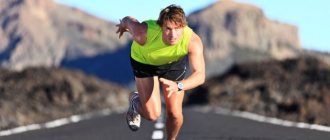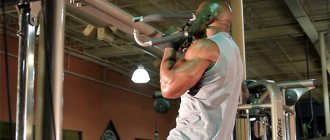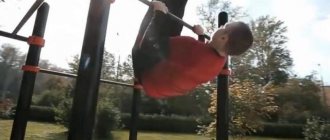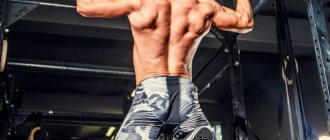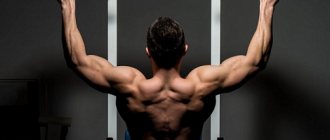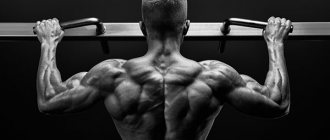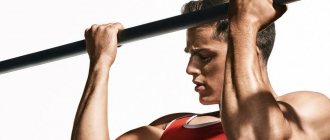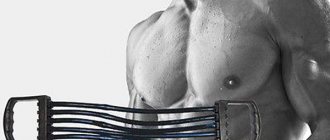Among the exercises that allow you to work with your own weight, pull-ups on the horizontal bar are considered the most common and accessible. They can be performed both in the gym and on the street. You can install the crossbar at home, which will make this exercise even more accessible. Pull-ups on the horizontal bar perfectly work the muscles and allow you to stretch the spine well. This positive effect of exercise is important not only for those who exercise to stay in good shape, but also for professional athletes.
You can do pull-ups anywhere. The main thing is that there is a crossbar. There is such a horizontal bar on almost every yard sports ground. Gyms also have pull-up bars. It is often done right in a house or apartment. It doesn't take up much space, but allows you to do pull-ups absolutely at any time. This exercise does not allow you to build up powerful muscles, but even those who want to become really big should not refuse it, since it helps improve the definition of both the back and arms.
In addition, by pulling yourself up, you can significantly increase your strength, that is, develop your back and arms. There are different variations of pull-ups, which are determined by the type of grip. Depending on the specific choice, the muscle group to be worked is determined.
Medium overhand grip
This is a classic option. This type of pull-up is performed both in physical education classes and by American special forces. The main emphasis is on the biceps and back muscles.
To perform this stretch, you must do the following:
- grab the horizontal bar with your hands spaced shoulder-width apart;
- hang and bend your back a little;
- cross your legs so that your body does not become loose;
- pull yourself up, bringing your shoulder blades together.
When the body is at the extreme point, you need to touch the crossbar with your upper chest. Muscles are best stretched when the arms are fully extended. Otherwise, it will not be possible to achieve full stretching.
Choosing the optimal type of pull-up
Everyone who starts doing pull-ups on horizontal bars is concerned about the specific method of performing the exercise. Athletes recommend starting pull-ups with a regular grip technique. This is a kind of classic or base, from which it will then be easy to move on to varieties of pull-ups.
Types of pull-ups are designed in such a way that each of them is “responsible” for pumping different muscle groups. Therefore, ideally, you need to take your technique to a level where each workout you perform a series of exercises with a full set of grips.
Wide-grip pull-ups are considered the most difficult - unlike classic pull-ups, they involve more muscles. In turn, a direct grip works the trapezius muscles, and pull-ups with different grips help develop the shoulder muscle. Each type of pull-up on a horizontal bar deserves attention, so you shouldn’t limit yourself to just one type of exercise. It will be much more effective to combine techniques and types of grips in order to achieve an even load on the entire upper body.
Medium overhand grip
Correct technique:
- The width of the arms is slightly wider than the width of the shoulders;
- outer direction of the palms (overhand grip);
- arms bend at the elbows at the peak point;
- the chin is above the bar;
- at the lowest point the arms are straight.
The most important thing is to perform the exercise without swaying the body, evenly raising and lowering the body. It is necessary to bring your shoulder blades together in the process and try to touch the bar with your upper chest, pulling yourself up to the peak point. In order to better stretch the muscles, at the lowest point you need to fully straighten your arms.
Athletes also recommend lowering the body twice as slow as raising it, since elbow extension is the most difficult phase to perform.
If a person cannot yet lower himself smoothly, he needs the help of a partner who will support the body and help him rise and fall.
Load:
- biceps;
- trapezius muscles;
- latissimus dorsi muscles.
Medium underhand grip
Correct technique:
- The grip width should correspond to the width of the shoulders;
- palms facing yourself (lower grip);
- when pulling up, it is necessary to direct your shoulders back and down from the very beginning of the movement;
- at the highest point the chin is above the crossbar;
- at the lowest point the arms are straightened.
This option is simpler than the previous one, since when performing pull-ups with a medium grip from below, the biceps work more than the brachialis muscle. For beginners, as a rule, it is the biceps that are stronger, so it is recommended to take a closer look at this option if you belong to this category.
Load emphasis:
- biceps;
- latissimus dorsi muscles.
Wide grip to chest
Correct technique:
- a wide grip is approximately similar to that used in the barbell press;
- the projectile should be grasped from above with the thumbs, which will help to more effectively develop the back muscles;
- you need to smoothly bring your shoulder blades together and try to touch the horizontal bar with your upper chest;
- you should look straight up and bend your back;
- At the top point you need to linger a little.
Wide-grip chest pull-ups are the most difficult, but also the most effective exercise option. Even athletes sometimes make mistakes in their technique, which can lead to a decrease in efficiency. If you perform wide-grip pull-ups correctly, you can see results after a short period of time.
Load:
- trapezius muscles;
- top of lats;
- paired round.
Wide head grip
Correct technique:
- tightening should be gradual;
- grip width, as in the previous technique;
- When doing a pull-up, you need to bend your back and make your legs straight;
- It is important to point your elbows down, not back, throughout the entire execution.
Pull-ups with a wide grip behind the head are also popular, but also quite dangerous. If your joints have poor mobility, it is not worth doing. You should be especially careful with the wide-grip pull-up technique, since if you do it carelessly or ignore the correct method of doing it, you can get seriously injured.
The load is distributed among the following types of muscles:
- paired teres muscles;
- trapezoidal;
- the upper and middle part of the latissimus muscles.
Narrow overhand grip
Correct technique:
- The grip width should be narrower than shoulder width;
- at the highest point, the hands should be on both sides of the chin;
- it is necessary to pull yourself up, bending your back;
- at the highest point you should touch the horizontal bar with your chest.
Close-grip pull-ups are suitable for those with poor wrist mobility. It is noteworthy that the narrower the grip, the more load is placed on the biceps. Therefore, if you are interested in pumping up these particular muscles, this version of the technique will suit you much better than pull-ups with a wide or medium grip.
Muscles that are pumped in this technique:
- lower latissimus muscles;
- toothed;
- brachial muscle.
Narrow underhand grip
Correct technique:
- you should grab the horizontal bar with a reverse grip, if possible, put your palms together;
- hanging on straight arms, arch your back and look at your hands;
- during the pull-up process, focus on moving your shoulders back as much as possible and bringing your shoulder blades together;
- at the top point, try to bend your back even further to touch the projectile with your lower chest.
Close-grip pull-ups are good for pulling the lats downward. This technique is worth including in your routine if you are focused on varied approaches and pumping as many muscles as possible.
The horizontal bar grip exercise is considered one of the best for pumping up the biceps, as it works its peak. It is due to pumping the peak of the biceps that the arm appears more muscular and voluminous.
Emphasis on the following muscle groups:
- lower latissimus muscles;
- biceps.
Neutral grip along the bar
Correct technique:
- you need to grab the crossbar so that one fist is in front of the other crosswise;
- when pulling up, you should actively bend your back;
- on the way out, try to touch the horizontal bar with your lower chest;
- at the top point, you should take turns turning your head in different directions from the horizontal bar;
- Between approaches you need to change the position of your hands in order to provide different loads.
The technology is notable for the fact that the grip width can be either regular or narrow. Depending on the choice of grip, different muscles are pumped. This is why the grip along the bar is popular - each athlete can choose individual parameters for pumping the muscles he needs.
Responsible for this type of technology:
- lower latissimus muscles;
- toothed;
- brachial muscle.
Partial pull-ups with underhand grip
Correct technique:
- grab the bar with a medium reverse grip;
- pull yourself up exactly halfway;
- At the highest point, fix the body at an angle of 90 degrees to the floor, then bend your arms, trying to bring your collarbones as close as possible to the crossbar.
Partial pull-ups are aimed at high-quality development of the biceps due to the principle of load concentration. Maximum tension is achieved if you use a small range of motion and do not connect the stretching and resting points of the biceps. The correct technique for performing pull-ups with an underhand grip involves keeping the body in constant tension. This can be done due to incomplete bending of the elbows.
The load goes on the following muscles:
- biceps brachii muscles;
- biceps.
Problems when pulling up
Pull-ups on horizontal bars, like any other exercise, are fraught with the appearance of nuances and various problems at different stages of training. There are four categories of problems that you may encounter when performing the exercise:
| Category | Description | Recommendations |
| First | Can perform 1-2 pull-ups in one approach | The result is normal for a beginner. It indicates that it is too early to exercise with your own weight. To improve your skills, you need to start with the passive part of the pull-up:
It is recommended to do 3 sets of 5 repetitions at first; the process of lowering the body lasts 5-6 seconds. After a couple of weeks, you can reduce the number to two and lower the body more slowly. In addition, to make pull-ups easier, you can perform the exercise by resting your feet on the floor and gradually increasing the load on your arms. If you can’t reach the bar with your chin, you can do the lift halfway, just bend your elbows as far as the load allows. |
| Second | 2-4 reps per set | The second group should stretch the number of approaches and reduce the number of repetitions. At the same time, do not forget about the maximum intensity of pull-ups. Thanks to this, a large number of muscle fibers will be under load, and neuromuscular connections will be strengthened. The first two weeks you need:
After two weeks, it is recommended to perform 8 approaches as many times as possible, with the same break. An exercise called the “static hang” also helps. You must initially take a lifting position with your arms bent, and then try to hold your body at the top point for as long as possible and perform the descent. |
| Third | Best attempt – 5-7 times | The problem for people in the third category is that they have sufficient strength but insufficient endurance. The recommendations are as follows:
|
| Fourth | 8-12 reps per set | If you are in this category, then your body weight is too low for you. Therefore, it is necessary to use weights in training. These can be either special weights or any acceptable option. The main rule that must be followed is that the weight of the equipment should not be higher than 10% of its own weight. This load will help reduce the number of repetitions by 3-4. |
Benefits of Pull-Ups
Pull-ups on the horizontal bar have a positive effect not only on the condition of the muscles. They have a number of other positive aspects:
- When performing a pull-up, the body is in good shape, all muscles are tense and involved with a high load.
- The horizontal bar or crossbar on which the exercise is performed can be found not only in the gym, but also in any yard, which makes pull-ups incredibly accessible.
- Thanks to tightening, you can prevent the appearance and development of diseases such as scoliosis, lordosis, kyphosis.
- During the exercise, your posture improves significantly.
- The body quickly acquires relief.
- Pull-ups can be performed either as independent exercises or combined with other sports elements - in any case they will be effective.
- Depending on the execution technique and grip width, different muscle groups are pumped. Therefore, it is possible to select an individual technique and method of implementation to meet specific requests.
Medium underhand grip
It is a simpler and easier to perform variation compared to the top one. This is due to the fact that the main part of the load is received by the biceps. Unlike the back, they are initially better suited to pull up. This type of exercise is ideal for beginners who have difficulty with an overhead grip.
The distance between the hands should be the same as when performing pull-ups with a wide overhand grip. The difference is that the palms do not turn away from themselves, but, on the contrary, towards themselves. Performing this exercise is no different in principle from the previous one, but when the shoulders begin to move up, they are pulled back and then down. During the entire pull-up, your forearms should remain perpendicular to the floor surface at all times.
Which grip to choose for beginners and experienced athletes
Pull-ups are a fairly difficult exercise. It is not easy for beginners to master immediately; mastering it in its “pure” form can be difficult, so trainers often advise starting classes with additional equipment - a gravitron or expanders. They make the exercise easier by “taking” part of the load onto themselves.
How to place your hands on the horizontal bar? Best of all - slightly wider than shoulder level with a reverse grip (fingers of the palms “look” at you). “When doing pull-ups with a direct grip, the brachioradialis muscle is activated to a greater extent, and when doing pull-ups with a reverse grip, the biceps is activated,” reminds Alexey Bolyaev. — Therefore, beginners should start with pull-ups with a reverse grip, since the auxiliary muscle in these exercises is the biceps, which is a priori larger and stronger than the brachioradialis muscle. This way, reverse grip pull-ups will be easier.”
Having mastered this type of pull-up, you can move on to others - for example, perform exercises with a straight grip. “A direct grip should be used by more trained athletes even if the load is intended to be directed to a greater extent on the back muscles,” says Alexey Bolyaev.
Do you want to increase the load? Try doing pull-ups with a narrow or wide grip, using weights (belt, weight), changing the position of your legs (throwing them up), etc.
Wide grip to chest
Pull-ups on the horizontal bar have a wide variety of effects on the muscles. This variety is considered the most useful. This powerful and beneficial exercise certainly requires a certain level of fitness and effort. This kind of pull-up scares beginners because it is not just difficult to do, but very difficult. Among those who regularly visit the gym, it is rare to meet people who know how to do it correctly. The exercise allows you to pump several spinal muscle groups at once - the latissimus, teres, and trapezius.
To do this pull-up, the bar of the horizontal bar is grasped from above. The grip should be such that your hands are at the same distance as when doing a bench press. An important nuance is that the thumb is not on the bottom, but on the top. This also applies to the other fingers. In other words, the crossbar is held on top. Thanks to this position, the back muscles are stretched as well and efficiently as possible. When pulling up, the biceps muscles should be relaxed.
The upward movement is carried out by bringing the shoulder blades together. It is necessary to stretch upward until the chest touches the bar. Achieving this position should be preceded by bending in the back and looking up. When they reach the extreme point, they linger in this position for several seconds.
Anatomy exercises
Pull-ups are one of the most accessible and effective exercises for strengthening muscle groups of the upper body: latissimus, biceps, brachialis, upper back, forearms, rectus abdominis (abs).
The latissimus muscle - the largest muscle of the body - originates from the armpits and, covering the lower corner of the shoulder blade, falls down, forming a “wing”. This muscle is responsible for bringing the elbows to the body in the vertical and sagittal planes (the plane of human symmetry). The latissimus muscles are not only the largest muscles of the back, but also the most “responsive” - they are the first to increase during strength load. Pull-ups on the horizontal bar are considered the basis for these muscles.
Next to the latissimus is the teres major muscle, which helps in bringing the elbows toward the body and pulling the shoulders back. Above the latissimus are the trapezius muscles. They are responsible for all movements of the shoulder blades, including “assisting” the rest of the muscles when extending the arms in the horizontal plane. Hidden under the trapezius muscle is the rhomboid muscle. All of these muscles are involved in doing pull-ups. The back extensor muscles, which are responsible for straightening and stabilizing the body, also receive a share of the load. In pull-ups, they are loaded to stabilize the spine.
When pulling up, almost all back muscles are involved in the work. The rotator cuff also works, and the fingers and hands are strengthened. The exercise strengthens the abs, which is also involved in stabilizing the position of the body in space, and the hips.
Pull-ups are an effective exercise for strengthening the biceps because... comprehensively trains it through the movement of two joints - the elbow and shoulder. This exercise will help not only significantly increase muscle mass, but also develop the functional strength of the trainee.
Regular pull-ups have a healing effect, work out the muscle corset and protect the back from injury, strengthen the posterior deltoid muscle of the shoulder. The correct technique strengthens the joints, which other back exercises cannot do.
Another nice bonus: pull-ups are the safest way to strengthen your back. The secret is that nature itself has incorporated the pull-up mechanism into the human body. Therefore, trainers and sports doctors recommend pull-ups even for those who have health problems. Thus, pull-ups are often included in the training program for people with musculoskeletal problems, since the exercise engages the spinal stabilizer muscles, which are responsible for the formation of posture. The main thing when performing all movements is to monitor the technique and gradually increase the load. Note: by changing the width and method of grip, you can influence different muscle groups. So, a reverse grip gives a good load on the biceps. Medium-grip pull-ups work the biceps, trapezius, and latissimus muscles. A wide grip better works the top of the lats, trapezius and round muscles of the back, while a narrow grip works the shoulders and the bottom of the lats. You can read more about grips in a separate article.
Wide head grip
Another common and quite popular variation of this exercise. The main nuance that you should remember when performing this version of pull-ups is that it is quite traumatic. Risk arises from incorrect execution. If the shoulder joints remain immobile, a very serious injury can occur. The load falls on the same muscle groups as when pulling with a wide grip to the chest, but the latissimus dorsi muscles are worked the most.
The width of the grip is similar to that of the bench press. When doing this exercise, you should under no circumstances bend your back. The body and legs should form an even, single line. The elbows must be kept pointing downwards at all times. They shouldn't look back. At the highest point, the neck should not come into contact with the surface of the crossbar.
Until the full range of movement is achieved, you need to spend a certain amount of time training. This allows you to master the correct technique. If you try to do a pull-up right away, you may get injured. A signal to stop further movement is pain in the back or shoulder joints. You can't stop moving suddenly. It is necessary to slowly lower to the starting position. This will avoid injury or minimize damage.
How else to use the horizontal bar?
If all the dumbbells and barbells in the area have disappeared, and the gyms are closed for renovations, you can turn to a workout and remember the horizontal bar and uneven bars. With the help of these simple sports equipment you can really effectively work out the body, add volume and relief to the muscles.
An approximate training program for working out the whole body in a regular sports field:
- wide grip pull-ups – 3 sets maximum of times;
- wide grip push-ups – 3x20;
- pull-ups with a narrow grip with body deviation - 3x20;
- parallel bars push-ups – 3x15;
- “diamond” push-ups – 3x10;
- lifting legs while hanging or supporting – 3x20.
This simple workout is suitable for beginners and people who want to stay fit in any conditions. A balanced diet and adequate alternation of training and rest will help speed up muscle gain and improve body contour.
Narrow overhand grip
Unlike previous variations, the grip is done with narrowly spaced hands. This exercise is great for those people whose wrist joints have limited mobility. When the bar is grabbed from below, pull-ups allow you to work out the serratus, lower latissimus muscles well. The shoulder muscles are also involved to some extent.
The palms on the bar should be as close to each other as possible. The thumbs are practically touching each other. Pull-ups are performed with a bend in the back. You should try to touch the lower part of your chest with the bar.
"Buildup"[edit | edit code]
Remember that pull-ups are performed using force, not inertia. But if there is not enough strength yet, any person will certainly want to help himself with his feet. For this, there is a special deceptive technique - swinging.
The swing loosens the joints and turns pull-ups into an illusion of incredible strength and shape. This is the main reason why novice athletes should never use this technique. Be sure to try to maintain the ideal form and trajectory of movement - two seconds up, a second at the top, two seconds down, a second at the bottom, etc.
No inertial moment. If you feel that it is difficult to continue, it is better to lower yourself, rest and repeat the exercises without swinging.
Only after you have mastered the technique and reached an advanced level without using swinging can you help yourself - and carefully use the moment of inertia: do three or four clean pull-ups and then, gently rocking, do two or three more repetitions.
Only if these conditions are met, pumping will help you overcome the natural barrier in the number of pull-ups and develop endurance. In any case, don't swing when you shouldn't. This technique cannot be used more than once per set. And don't even try to use the swinging technique if you are a beginner.
Narrow underhand grip
This type of pull-up is easier than the previous one. It is performed either when it is difficult to do an exercise with an upper narrow grip, or to stretch the latissimus dorsi muscles. Along with this muscle group, the biceps are also worked out.
Similar to the previous option, this exercise also involves placing your hands as close to each other as possible. The difference is that the palms are facing towards you. When they weigh on straight arms, they bend in the back and look at the hands. You need to focus on bringing your shoulder blades together and moving your shoulders back. Pulling up to the extreme point, they try to bend more strongly in the back and touch the horizontal bar with the lower part of the chest.
Recommendations and tips
While you are pulling yourself up to the horizontal bar, do not strain your biceps. The only task of your hands at this moment is to hold the bar firmly, without allowing your body to sway.
The wider the grip, the more convenient it is to train. Due to the fact that the visual width of the back is determined by the upper part of the lats, in order to pump them up, the grip should be made wider. With a narrower palm position, the load is focused on the lower part of the latissimus and pectoral muscles.
In order not to reduce the amplitude of contraction of the lats, keep your elbows in the correct position, do not bring them closer to the body, keep your chin slightly higher than the horizontal bar.
Beginners are advised to seek the help of a trainer or other partner who will help pull the body towards the bar until the head is at the desired level.
Neutral grip along the bar
It is a rather specific type of pull-up on a horizontal bar. This pull-up is aimed at working the latissimus inferior serratus muscles and to some extent the shoulder muscles. The bar is grasped so that one palm is in front of the other. While doing pull-ups, bend your back and try to touch the bar with your chest (lower part). The head is turned away from the projectile, changing sides with each pull-up. Hands change with a new approach. To make the exercise more comfortable, a V-shaped handle is often hung on the horizontal bar.
How a pull-up can save a life
Imagine an ordinary day for a person. He rides the subway, raising his hands and grabbing the handrails. He lifts heavy objects from the top shelves and puts them back. Finally, he carries the shopping bags up the stairs and rocks the baby. What is this? All of these movements work your back. The stronger the back muscles, the fewer household injuries you can get. Strong muscles also protect against injuries from falls on ice and unstable surfaces.
Pull-ups help get rid of back pain, which is often considered a symptom of osteochondrosis. In fact, they are caused by muscle spasms and vertebral displacements, which provoke pinching of the nerve roots. Such pain occurs in people with weak, untrained muscles. Therefore, it is important to pull yourself up if the work is office and you need to spend more than 8 hours on it.
Of course, the skill of lifting your own weight with your hands can also help in extreme situations. Fires, floods, escape from criminals - all this is easier to survive if you can climb onto a stable support in a safe place.
In addition, it is also important for representatives of certain professions to catch up - we are talking about those who want to connect their lives with the fight against crime, fires, protecting people in extreme situations and medicine. Yes, strong arms and back are sometimes necessary to turn the patient over and place him on a stable surface to perform manipulations.
Partial pull-ups with underhand grip
These pull-ups are aimed at working the biceps. They allow you to concentrate the load. The horizontal bar bar is grasped with a reverse medium grip, when a right angle is formed between the forearm and shoulder. Having taken the starting position, they pull themselves up exactly to the middle. The body should be fixed vertically, and then begin to move upward, trying to touch the crossbar with the collarbones. Lack of stretching and low amplitude allow you to get maximum load.
TYPES OF PULL-UPS ON THE PULL-UP BAR from LvL 1 to LvL 80 and what muscles work in each
Body weights and pull-ups[edit | edit code]
Pull-ups require you to lift your entire body weight, which is what makes them different from other exercises. Literally, this means that every additional kilogram of weight you have to lift upward. The more excess weight you have, the more difficult it will be to do pull-ups and the worse your results will be.
Muscle weight is not a hindrance to pull-ups: if you have a lot of it, it will be easier to do pull-ups.
But if the excess weight exceeds 13 kg, your chances of advancing beyond the Fifth Level are practically zero, unless you have crazy strength and do not use deception techniques. Otherwise, just keep working on pull-ups, paying as much attention to technique as possible, doing other Big 6 exercises, going on a diet - you will certainly succeed.
Training program on the horizontal bar
Doing pull-ups, like any other exercise, requires practice. You should start with them only after you have determined your maximum. Next, having decided on a group, they begin to train at least twice a week, and after a month they repeat the test. If the indicators have increased, move on to the next level of difficulty.
Category one – one or two pull-ups
People who manage to do no more than two pull-ups in one approach have the weakest level. They should begin working with passive pull-ups where body weight loading is kept to a minimum. This involves using a bench, that is, lifting with the use of your legs. The lowering is carried out under the force of its own weight. For the first 14 days, you should train in 3 sets, in each of which up to 5 repetitions are done, when the lowering takes at least 5-6 seconds. Then it is increased to 8 or 10 seconds, but no more than two approaches are done.
Category two—from two to four attempts
Those who manage to perform two or more successful pull-ups should do more approaches, but with fewer repetitions. The first repetitions must be performed intensely in order to load as many muscle fibers as possible, maximizing the neuromuscular connection. The first two weeks of training, do eight approaches, each of which should contain exactly half the repetitions of the best indicator when first testing your ability. Between individual rest cycles for 1-1.5 minutes. The further training schedule already involves performing in each set the full number of pull-ups that were done on the first attempt.
Category three - from 5 to 7 pull-ups
People who are able to do 5 or even 7 pull-ups are strong, but not yet very resilient. They can perform the exercise without any set counting. The rest between individual approaches can be anything. The main task is to do at least three or four sets.
Category four - from 8 to 12 times
Those who are able to do at least eight pull-ups in one approach are already too resilient and strong to work with their own weight. To improve your results, you need to use weights that should be no more than 10% of your own weight. The additional load will reduce the number of repetitions by three or four times, but will allow you to get maximum effect.
How to pump up your chest: push-ups and presses
Having understood the features of the target zone, it becomes clear that voluminous breasts cannot be formed on the horizontal bar. The following exercises will help pump up this area:
- push ups;
- barbell or dumbbell press;
- bench press;
- raising hands;
- Svend press.
These four exercises can create a very effective chest workout that is suitable for both beginners and experienced athletes. Classic techniques are recommended for beginners, while those with sufficient experience can complicate the execution in many different ways.
- You should start with push-ups. This is a basic exercise, after which the muscles are quite tired, but in general they are still capable of further work. The main question is what grip to do push-ups to pump up your pectoral muscles. To develop this area, the arms must be placed as wide as possible, that is, there should be a distance between the hands equal to one and a half shoulder widths. It is with this positioning of the arms that the pectoralis major muscle works. Other nuances: lower yourself almost until your nipples touch the floor, your elbows should not “walk” to the sides. The downward movement is smooth, the body should be pushed up with maximum force.
- The press of any apparatus is the second basic exercise for the chest. You can use a barbell or dumbbells. If you don’t have anything at hand, even an ordinary barbell will come to the rescue, although holding it in your hands is inconvenient. To work the target zone, the press is performed lying down. The weight is used about 80% of the maximum, no more is needed, otherwise you will not have enough strength to complete the workout.
- The chest press is suitable for those who work out in the gym. It is recommended to use an incline bench - this will allow you to focus on the middle and lower chest. In essence, the movement is reminiscent of working with a barbell or dumbbells, but much simplified.
- The Svend press will help “finish off” the area being worked. This vainly forgotten exercise is a bench press of one plate held between the palms. Performed while standing.
- It is recommended to finish the workout by lifting your arms with dumbbells (lying) or doing a butterfly bench press. Both exercises effectively stretch the pecs.
All of the listed exercises should be performed in 3-4 sets of 10-15 times, depending on the form.
What muscles are involved in pull-ups?
Pull-ups are a multi-joint exercise that involves the entire group of muscles in the shoulder girdle. You must know them in order to understand what to train and which exercises are best to use.
Core muscles
- Latissimus
- Biceps
- Teres muscle
- Brachialis
- Brachioradialis
Accessory muscles
- Deltoid
- Triceps
- Chest
- Diamond-shaped
- Trapezoidal
Muscles when pulling up
One-arm pull-up
To learn how to use this type of pull-up technique, you need to master the overhand grip 10 times. Initially, you need to pull yourself up with both hands, but at the moment of lowering down, you need to release one hand. At first it will be possible to lower your body quite quickly. But gradually the muscles will begin to strengthen and allow you to descend smoothly and slowly. When pulling up and down is most effective, the chin will be close to the hand. To avoid pain in the elbow joint, the load should be carried out gradually. During the exercise, the arm should not be completely straightened, and the shoulders should be kept tense. At home, using grips on the horizontal bar will help novice athletes prepare for serious loads. And for those who are already involved in sports professionally, always keep themselves in shape.
